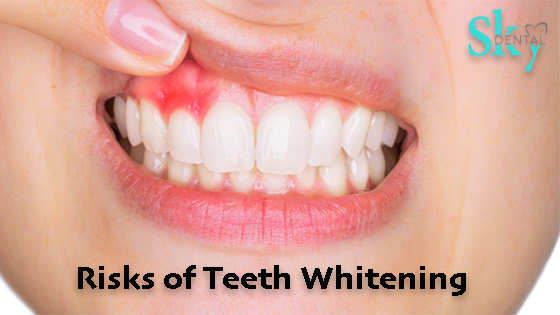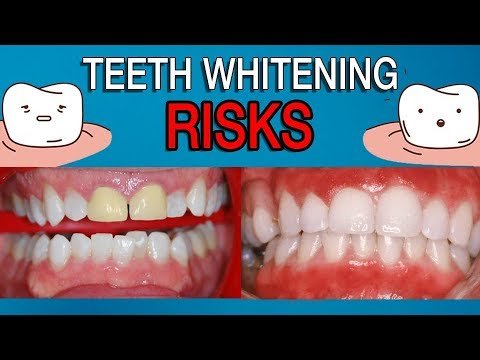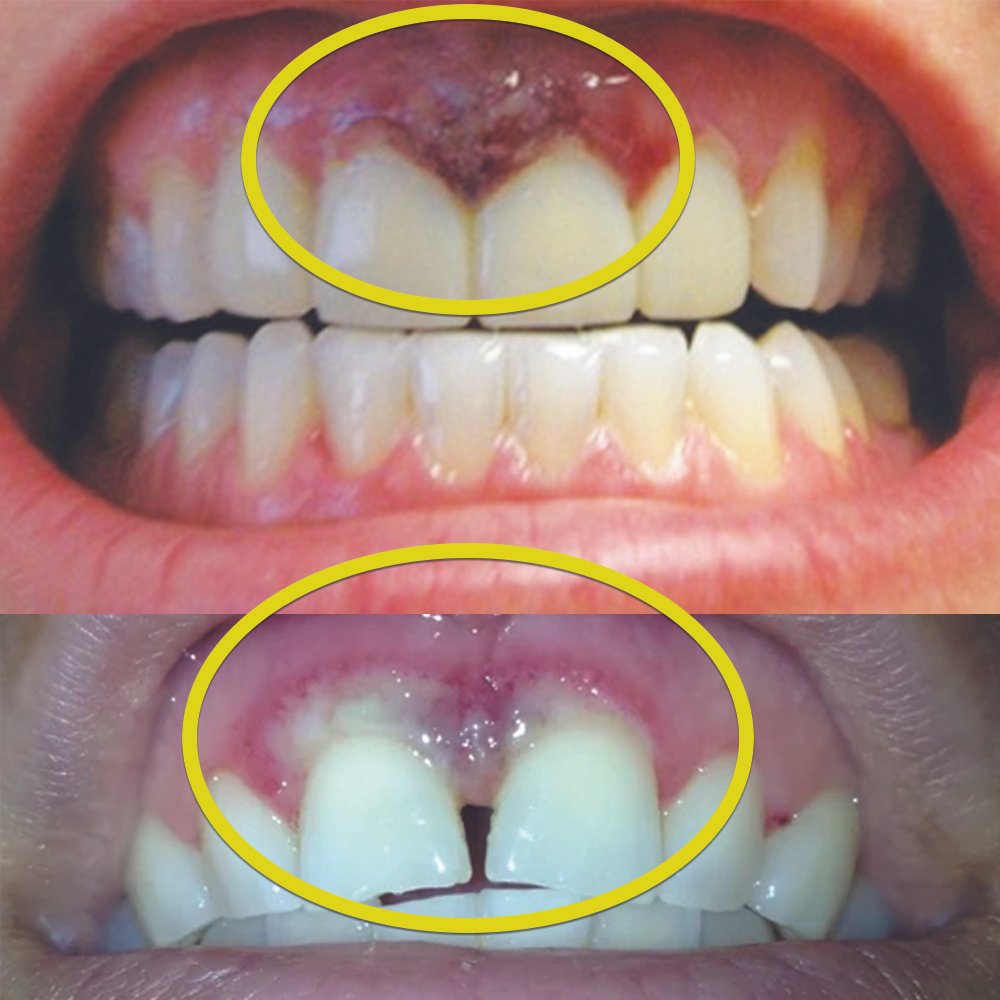Are you considering teeth whitening but unsure about the potential risks? This article aims to shed light on the topic and answer the question: Are there any risks associated with teeth whitening? Discover the possible side effects, precautions to take, and how to ensure a safe and successful teeth whitening experience.

This image is property of skydental.co.in.
1. The Basics of Teeth Whitening
1.1 What is teeth whitening?
Teeth whitening is a popular cosmetic dental procedure that aims to remove stains and discoloration from the surface of teeth, resulting in a brighter and more attractive smile. It can be done in a dental office or at home using various whitening products.
1.2 How does teeth whitening work?
Teeth whitening works by using bleaching agents to penetrate the enamel of the teeth and break up the stains. The most common bleaching agent used is hydrogen peroxide or carbamide peroxide, which releases oxygen molecules that break down the molecules causing discoloration.
1.3 Popular teeth whitening methods
There are several popular teeth whitening methods available. In-office professional teeth whitening treatments are performed by dentists and typically involve the use of a stronger bleaching agent that provides immediate and noticeable results. At-home teeth whitening options include whitening toothpaste, whitening strips, and whitening trays with a lower concentration of the bleaching agent, allowing for gradual whitening over a period of time.
2. Common Side Effects of Teeth Whitening
2.1 Tooth Sensitivity
One of the most common side effects of teeth whitening is tooth sensitivity. This occurs when the bleaching agent comes into contact with the nerves in the teeth, causing temporary pain or discomfort. This sensitivity is usually temporary and subsides after the whitening treatment is completed.
2.2 Gum Irritation
Some individuals may experience gum irritation as a side effect of teeth whitening. This can be caused by the bleaching agent coming into contact with the gums or the use of ill-fitting whitening trays. Proper technique and following instructions provided by the dentist or manufacturer can help minimize gum irritation.
2.3 Soft Tissue Burns
In rare cases, teeth whitening can lead to soft tissue burns. This can occur if the bleaching agent is not properly applied or if the concentration is too high. It is important to follow instructions carefully and seek professional guidance to minimize the risk of soft tissue burns.
2.4 Uneven Whitening
Another potential side effect of teeth whitening is uneven whitening. This occurs when the bleaching agent does not distribute evenly across the teeth, resulting in patches or spots of lighter and darker shades. This can be caused by improper application or the presence of existing dental restorations.
2.5 Temporary Teeth Sensitivity
In addition to tooth sensitivity during the whitening process, some individuals may experience temporary teeth sensitivity after the treatment. This sensitivity usually subsides within a few days to a week, but it is important to avoid consuming extremely hot or cold foods and beverages during this time.

This image is property of i.ytimg.com.
3. Potential Risks of Teeth Whitening
3.1 Enamel Damage
One potential risk of teeth whitening is enamel damage. Enamel is the outer protective layer of the teeth, and excessive and improper use of bleaching agents can weaken the enamel, making the teeth more susceptible to cavities and decay. It is essential to follow instructions provided by a dental professional to minimize the risk of enamel damage.
3.2 Increased Tooth Sensitivity
Teeth whitening treatments can potentially increase tooth sensitivity, especially in individuals who already have sensitive teeth. The bleaching agents can irritate the nerves in the teeth and lead to heightened sensitivity. If you already have sensitive teeth, it is important to consult with a dentist before undergoing any whitening treatments.
3.3 Irritation or Damage to the Gums
As mentioned earlier, teeth whitening can lead to gum irritation if the bleaching agent comes into contact with the gums. Prolonged exposure or improper application of the whitening agent can cause gum damage, including inflammation and ulceration. Seeking professional guidance and using the appropriate whitening technique can help minimize the risk of gum irritation or damage.
3.4 Allergic Reactions
In rare cases, individuals may experience allergic reactions to the bleaching agents used in teeth whitening treatments. This can manifest as oral itching, swelling, or hives. If you have a history of allergies or are prone to allergic reactions, it is important to consult with a dentist and discuss potential alternative whitening options.
3.5 Impact on Tooth Restorations
Teeth whitening treatments may not have the same effect on dental restorations, such as crowns, veneers, or fillings. While natural teeth may become whiter, the restorations may remain the same shade. This can result in an uneven appearance of the teeth. It is important to discuss this with a dental professional prior to teeth whitening if you have any dental restorations.
4. Professional Teeth Whitening vs. DIY Options
4.1 Benefits of Professional Teeth Whitening
Professional teeth whitening treatments performed by dentists offer several benefits over DIY options. Dentists have access to stronger bleaching agents and advanced techniques that can provide more efficient and noticeable results in a shorter time. They can also tailor the treatment to each individual’s specific needs, ensuring optimal results and minimizing the risk of side effects.
4.2 Risks of DIY Teeth Whitening
Although DIY teeth whitening options are convenient and cost-effective, they also come with their own risks. Over-the-counter whitening products may have lower concentrations of the bleaching agent and may not provide the same level of effectiveness as professional treatments. Improper use or using the products for an extended period can lead to adverse effects such as tooth sensitivity or gum irritation.
4.3 Important Considerations
Before deciding between professional teeth whitening or DIY options, it is important to consider factors such as the severity of discoloration, existing dental restorations, and individual preferences. Consulting with a dentist can help assess the suitability of each option and determine the best course of action for achieving the desired results.

This image is property of www.drbk.co.uk.
5. Precautions to Minimize Risks
5.1 Consultation with a Dentist
To minimize the risks associated with teeth whitening, it is essential to consult with a dentist before undergoing any treatment. A dental professional can evaluate the condition of your teeth and gums, assess the suitability of teeth whitening, and provide personalized recommendations to ensure safe and effective results.
5.2 Follow Instructions and Recommended Dosages
Whether using professional treatments or DIY options, it is crucial to follow the instructions and recommended dosages provided by the dentist or the product manufacturer. Applying excessive amounts of the bleaching agent or using it for longer than instructed can increase the risk of side effects.
5.3 Protecting the Gums
To minimize the risk of gum irritation or damage, it is important to protect the gums during teeth whitening treatments. This can be achieved by using custom-fit trays or by applying a protective gel provided by the dentist. Proper technique and application can help safeguard the gums and ensure a comfortable experience.
5.4 Avoid Acidic or Staining Foods and Beverages
After teeth whitening, it is recommended to avoid consuming acidic or staining foods and beverages that can potentially reverse the whitening effects or cause further staining. Examples include coffee, tea, red wine, citrus fruits, and tomato-based products. Maintaining a balanced diet and practicing good oral hygiene can help maintain the results of teeth whitening treatments.
5.5 Regular Oral Hygiene
Maintaining regular oral hygiene practices, such as brushing twice a day, flossing daily, and scheduling routine dental check-ups, is crucial for overall oral health and preserving the results of teeth whitening treatments. Good oral hygiene helps prevent dental issues and ensures long-lasting whitening effects.
6. Safety Measures for Whitening at Home
6.1 Choosing the Right Product
When opting for DIY teeth whitening, it is important to choose the right product. Look for products that have been approved by reputable dental associations and follow safety guidelines. Reading reviews and seeking recommendations from dental professionals can help in selecting an effective and safe whitening product.
6.2 Patch Testing
Before using any whitening product, it is advisable to perform a patch test on a small area of the teeth or gums to check for any adverse reactions. This can help identify potential allergies or sensitivities and determine the suitability of the whitening product.
6.3 Using Custom-Fit Trays
If using whitening trays at home, it is beneficial to use custom-fit trays provided by a dental professional. Custom-fit trays ensure the even distribution of the bleaching agent and minimize the risk of gum irritation. Avoid using ill-fitting trays that can allow the bleaching agent to come into contact with the gums.
6.4 Proper Technique for Applying Whitening Agents
Following the correct technique for applying whitening agents can help ensure safe and effective results. This includes applying the product evenly on the teeth, avoiding contact with the gums, and not exceeding the recommended application time or dosage.
6.5 Avoid Overuse of Whitening Products
Overuse of whitening products can lead to increased tooth sensitivity, gum irritation, or enamel damage. It is important to adhere to the recommended usage guidelines and not exceed the recommended duration or frequency of use. Giving the teeth sufficient time to rest between whitening treatments is essential.

This image is property of www.life-like.com.
7. Teeth Whitening and Dental Conditions
7.1 Dental Cavities
Teeth whitening treatments should not be performed on individuals with untreated dental cavities. The bleaching agents can penetrate the cavities and potentially cause further damage. It is crucial to address any underlying dental issues before undergoing teeth whitening.
7.2 Gum Disease
If you have gum disease, it is important to consult with a dentist before pursuing teeth whitening. Gum disease can cause gum sensitivity and inflammation, which can be exacerbated by the bleaching agents used in teeth whitening treatments. The dentist can assess the condition of your gums and determine the appropriate course of action.
7.3 Tooth Sensitivity or Enamel Erosion
Individuals with tooth sensitivity or enamel erosion should exercise caution when considering teeth whitening. The bleaching agents can further irritate the already sensitive teeth or compromise the weakened enamel. A dental professional can advise on suitable alternatives or recommend treatments to address tooth sensitivity or enamel erosion before teeth whitening.
7.4 Worn Enamel or Tooth Decay
Teeth whitening may not be recommended for individuals with excessive enamel erosion or advanced tooth decay. The bleaching agents can potentially worsen the condition of the teeth and cause further damage. It is important to prioritize addressing these dental issues before pursuing teeth whitening.
7.5 Pregnancy and Breastfeeding
During pregnancy and breastfeeding, it is generally advisable to avoid teeth whitening treatments. While there is limited research on the safety of teeth whitening during these periods, it is best to err on the side of caution and prioritize the health of both the mother and the baby. Consult with a dentist to discuss alternative options.
8. Potential Risks for Individuals
8.1 Individuals with Hypersensitivity
Individuals with pre-existing tooth sensitivity may be at a higher risk of experiencing heightened sensitivity as a result of teeth whitening treatments. A dentist can assess the level of sensitivity and recommend suitable alternatives or treatments to minimize the risk of discomfort.
8.2 Teeth Whitening for Teens
Teeth whitening treatments for teenagers should only be considered under the supervision of a dentist. The teenage years are crucial for the development of teeth and gums, and it is important to seek professional guidance to ensure the safety and effectiveness of teeth whitening in this age group.
8.3 Risks for Individuals with Restorations
Dental restorations such as crowns, veneers, or fillings may not respond to teeth whitening treatments in the same way as natural teeth. This can result in an uneven appearance or color discrepancy. It is important to discuss the potential risks and alternatives with a dentist before undergoing teeth whitening if you have dental restorations.
8.4 Risks for Individuals with Orthodontic Appliances
Individuals with orthodontic appliances, such as braces or clear aligners, should consult with their orthodontist before undergoing teeth whitening treatments. The bleaching agents used in teeth whitening can interact with the materials of the appliances, compromising their effectiveness or causing discoloration.
8.5 Risks for Individuals with Bruxism or Teeth Grinding
Individuals with bruxism or teeth grinding may be at a higher risk of experiencing side effects from teeth whitening treatments. The grinding action can sometimes cause the bleaching agent to penetrate the teeth more deeply, leading to increased tooth sensitivity or enamel damage. A dentist can provide guidance and recommend suitable precautions.

This image is property of www.drpamelali.ca.
9. Clinical Studies and Research
9.1 Long-term Effects and Safety Studies
Ongoing clinical studies and research are being conducted to evaluate the long-term effects and safety of teeth whitening treatments. These studies aim to assess the impacts on tooth enamel, gum health, and overall oral health after prolonged use of bleaching agents. The results of these studies will provide valuable insights into the safety and efficacy of teeth whitening.
9.2 Comparison of Different Whitening Techniques
Research is also being conducted to compare the effectiveness and safety of different teeth whitening techniques. This includes assessing the outcomes of professional in-office treatments versus at-home options, as well as evaluating the impact of different concentrations of bleaching agents. These studies can help inform individuals in making informed decisions about their teeth whitening methods.
9.3 Assessment of Side Effects
The assessment of side effects associated with teeth whitening is an important area of research. Studies aim to identify the prevalence and severity of tooth sensitivity, gum irritation, and other potential adverse effects. This research helps in understanding the risk factors and developing strategies to minimize side effects.
9.4 Evaluating Safety Measures
Research is being conducted to evaluate the effectiveness of different safety measures in teeth whitening treatments. This includes assessing the protective effects of custom-fit trays, gingival barriers, and other techniques employed to safeguard the gums and surrounding oral tissues during the whitening process. The findings from such studies contribute to the development of standardized safety protocols.
9.5 Recommendations for Future Research
As teeth whitening continues to be a popular cosmetic procedure, further research is necessary to examine specific areas of concern. Future studies may focus on exploring alternative whitening agents or techniques, investigating the long-term effects of teeth whitening on oral health, and developing innovative approaches for minimizing side effects. These recommendations can guide researchers in addressing the evolving needs of individuals seeking teeth whitening treatments.
10. The Importance of Professional Guidance
10.1 Dentists’ Expertise and Knowledge
Seeking professional guidance from a dentist is vital when considering teeth whitening. Dentists have the expertise and knowledge to assess your oral health, determine the suitability of teeth whitening treatments, and guide you towards safe and effective options. Their training and experience ensure that you receive personalized care and minimize potential risks.
10.2 Individualized Treatment Plans
Dentists develop individualized treatment plans based on the specific needs and goals of each patient. They consider factors such as existing dental restorations, oral health conditions, and personal preferences to tailor the teeth whitening treatment to optimize results. This personalized approach ensures that you receive the most suitable and beneficial treatment.
10.3 Professional Monitoring and Follow-up
Choosing professional teeth whitening allows for ongoing monitoring and follow-up by a dental professional. Regular check-ups and evaluations permit adjustments to be made during the whitening process, ensuring optimal results and minimizing the risk of side effects. Professional monitoring also provides a level of reassurance and peace of mind.
10.4 Considerations for Optimal Oral Health
Dentists prioritize oral health and hygiene when advising on teeth whitening treatments. They can identify and address any underlying dental issues before proceeding with whitening to maximize the desired results. By considering the overall oral health, dentists help maintain the integrity of the teeth and gums throughout the whitening process.
10.5 Seek Professional Advice
In conclusion, if you are considering teeth whitening, it is important to seek professional advice from a dentist. Professional guidance ensures that you understand the potential risks and benefits associated with teeth whitening. Dentists can provide individualized treatment plans, monitor progress, and minimize the likelihood of adverse effects. By prioritizing professional advice, you can achieve a whiter and brighter smile safely and effectively.